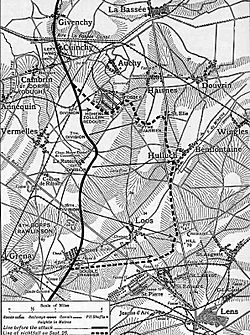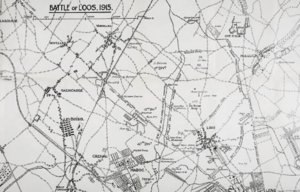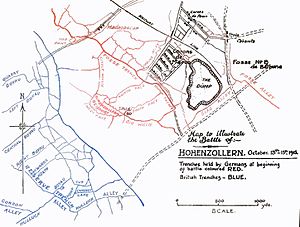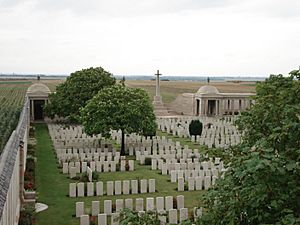Battle of Loos facts for kids
Quick facts for kids Battle of Loos |
|||||||
|---|---|---|---|---|---|---|---|
| Part of the Western Front of the First World War | |||||||
 Battle of Loos |
|||||||
|
|||||||
| Belligerents | |||||||
| Commanders and leaders | |||||||
| Strength | |||||||
| 6 divisions | 3 divisions | ||||||
| Casualties and losses | |||||||
| 59,247 | c. 26,000 | ||||||
The Battle of Loos was a major battle during the First World War. It happened in France on the Western Front from 25 September to 8 October 1915. This was the biggest attack by the British army in 1915.
It was also the first time the British used poison gas in a large attack. New army units, made up of volunteers, fought in a big battle for the first time. The French and British armies wanted to break through the German defenses. They hoped to start a war of movement again, instead of the slow trench warfare.
Even with new methods and more supplies, the German army mostly stopped the attacks. The British gas attack did not work as planned. Their artillery fire was also too short to destroy the enemy's barbed wire or machine gun nests. The German defenses were much stronger than the British attack plans. This led to a British defeat.
Contents
What Happened Before the Battle?
Why Was Loos Chosen?
The Battle of Loos was part of a bigger attack by the French and British armies. This was called the Third Battle of Artois. British commanders like Field Marshal Sir John French and Douglas Haig did not think the area around Loos was good for an attack. The Germans held high ground there, like slag heaps (piles of waste from mining) and colliery towers. They also knew the Germans had built a second line of defenses.
However, the French commander, Ferdinand Foch, wanted the attack there. The British Secretary of State for War, Herbert Kitchener, agreed with Foch. So, the British commanders had to follow this plan.
Preparing for the Attack
The British decided to use poison gas in this battle. At a meeting in September, General Haig said that using a lot of chlorine gas could help them advance. They tried to keep the gas attack a secret.
For the first time, special Royal Engineer tunnelling companies dug tunnels under "no-man's-land." This was the area between the two armies' trenches. They planted mines under the German front line. These mines were set to explode when the attack began.
The British Plan
General French kept some of his troops, like the Guards Division, as a reserve. These troops were new to fighting in France. An advisor suggested they were better for long marches after a breakthrough, not for trench warfare.
French was not sure if a breakthrough would happen. Haig wanted these reserve troops closer to the front. He wanted them ready to join the fight on the first day. French agreed to move them closer but still thought they should only be used on the second day.
The British army did not have enough artillery shells. This meant their bombing of German lines before the attack was not strong enough. They had only 533 guns to cover a very long front line. This made it hard to destroy the German defenses. The British also did not realize that the Germans had machine gun nests hidden on the other side of hills.
About 140 tons of chlorine gas were released before the attack. But the results were mixed. In some places, the wind blew the gas back onto the British trenches. This caused problems for their own soldiers. Many soldiers took off their gas masks because they couldn't see or breathe well. This meant they were hurt by their own gas.
The Battle Begins
September 25: The First Day
On the first day of the battle, the British artillery had not cut the German barbed wire in many places. The engineers who handled the poison gas warned against using it. They said the wind was too weak and unpredictable. But their warnings were ignored.
As predicted, in some areas, the gas blew back into the British lines. This caused more British soldiers to be hurt than German soldiers. The British infantry had to advance across open fields. German machine guns and artillery fired at them, causing many casualties.
The British did manage to break through some weaker German defenses. They captured the village of Loos-en-Gohelle. This was mostly because they had more soldiers. However, problems with supplies and communication, along with the late arrival of reserve troops, meant they could not use this success. The reserve divisions had to march for most of the day and night on bad roads.
September 26–28: German Counter-attacks
By the next day, the Germans had recovered. They had also made their defenses stronger. Much of the barbed wire, which was 30 feet deep in some places, was still intact. The British had also used up their supply of chlorine gas.
British attempts to keep attacking with the reserve troops were stopped. One attack by twelve battalions (groups of soldiers) lost 8,000 out of 10,000 men in just four hours. The German machine gunners said they felt sick from seeing so many dead bodies. They even stopped firing so the British could take their wounded soldiers away.
By September 28, the British were back where they started. They had lost more than 20,000 soldiers, including three major-generals.
Air Operations
The Royal Flying Corps (RFC), which was the British air force, helped in the battle. They flew missions to find targets for the artillery. This helped make sure shells were not wasted.
During the first few days, planes with better radios helped direct British artillery fire onto German targets. Later in the battle, pilots dropped 100-pound bombs on German troops, trains, and railway lines. This was one of the first times planes were used for tactical bombing. When the ground attack slowed down, British pilots flew low over German positions. They gave information to the artillery to help them target the enemy.
After the Battle
Casualties
The British army suffered heavy losses in the Battle of Loos. About 59,247 British soldiers were killed or wounded. The Germans lost around 26,000 soldiers. Many commanding officers from the Commonwealth armies were also killed or wounded.
Later Fighting
Hohenzollern Redoubt
The Germans tried several times to take back a strong point called the Hohenzollern Redoubt. They succeeded on October 3. On October 8, the Germans tried to get back more of the land they had lost. They attacked with five regiments.
Foggy weather made it hard to see, and their artillery fire was not good enough. The British and French defenders were ready behind their intact wire. The German attack was stopped, and they lost 3,000 soldiers. This attack did, however, delay British plans for another attack.
The British made a final attack on October 13. But it failed because they did not have enough hand grenades. Heavy rain and accurate German shelling in late October made the British give up on any further attacks.
Remembering the Battle
The Loos Memorial remembers over 20,000 soldiers from Britain and the Commonwealth. These soldiers died in the battle and have no known grave.
A community in British Columbia, Canada, even changed its name to Loos to honor the battle. Many soldiers who fought there wrote about their experiences. Robert Graves wrote about it in his book Good-Bye to All That. Patrick MacGill described the battle in his novel The Great Push.
Victoria Cross Awards
Many brave soldiers received the Victoria Cross, the highest award for bravery in the British military, for their actions at Loos:
- Daniel Laidlaw, 7th (Service) Battalion, King's Own Scottish Borderers.
- Frederick Henry Johnson, 73rd Field Company, Corps of Royal Engineers, 15th Division.
- Harry Wells, 2nd Battalion Royal Sussex Regiment.
- Anketell Moutray Read, 1st Battalion, Northamptonshire Regiment (awarded after his death).
- Henry Edward Kenny, 1st Battalion, Loyal North Lancashire Regiment.
- George Stanley Peachment, 2nd Battalion, King's Royal Rifle Corps.
- Arthur Vickers, 2nd Battalion, Royal Warwickshire Regiment.
- George Maling, Royal Army Medical Corps.
- Kulbir Thapa, 2nd Battalion, 3rd Queen Alexandra's Own Gurkha Rifles.
- Rupert Price Hallowes, 4th Battalion, Middlesex Regiment.
- Angus Falconer Douglas-Hamilton, 6th (Service) Battalion, Queen's Own Cameron Highlanders.
- Arthur Frederick Saunders, 9th (Service) Battalion, Suffolk Regiment.
- Robert Dunsire, 13th (Service) Battalion, Royal Scots.
- James Dalgleish Pollock, 5th (Service) Battalion, Queen's Own Cameron Highlanders.
- Alexander Buller Turner, 3rd Battalion, Royal Berkshire Regiment (awarded after his death).
- Alfred Alexander Burt, 1/1st Battalion, Hertfordshire Regiment.
- Arthur Fleming-Sandes, 2nd Battalion, East Surrey Regiment.
- Samuel Harvey, 1st Battalion, York and Lancaster Regiment.
- Oliver Brooks, 3rd Battalion, Coldstream Guards.
- James Lennox Dawson, 187th Company, Corps of Royal Engineers.
- Geoffrey Vickers, Sherwood Foresters (Nottinghamshire and Derbyshire Regiment).
See also
- John Kipling - killed in action during Battle of Loos, September 1915
- Charles Sorley - killed in action during Battle of Loos, October 1915




